Notes phytochemist. Banana skin strikes back
- Tutorial
The banana is great, and the peel is even more ...
( magazine "Technology - youth" No. 8 for 1986)
Peel banana got the unenviable fate. If the peel of apples is used at least to get apple pectin , then in the case of a banana peel there is only one way - to the dumpster ... But the thing is not easy, it will help to slip, and ethylene will be released for ripening. And besides, with such a simple and uncomplicated thing as the skin are connected such global things as anti-nutrients, non-lethal drug bananadine and blackening of the skin from sunburn. In general, I propose to understand and restore phyto justice.
For details - under the cat.

By the way, despite the fact that almost from the 19th century, banana peel has been used as a “national” symbol of gliding (I would probably even sell CIATIM with a banana logo), as far as I am aware, serious research on the mechanism of this phenomenon has not been done so far. People (see below) even the ships were lowered from the stocks using a banana peel, and only Japanese from Kitasato University came up with an estimate of the tribological properties (coefficient of friction there, something else on trifles). These are Kiyoshi Mabuchi and associates (Kensei Tanaka, Daichi Uchijima, Rina Sakai). Apparently, at one point in 2012, after eating sake, the guys took up the bananas , so much so that they gained the Ig Nobel Prize in 2014(generally I am inclined to think that a scientist who cannot do a funny or funny thing in his specialty is a “not real” scientist).
What exactly did they do? First, they measured the coefficient of friction between the surface (wooden / concrete floor) and the boot and traced how the banana peel influences this coefficient. It turned out that the average friction coefficient of a banana over linoleum was 0.066 (for a banana, the hardwood flooring was 0.083), which is pretty good, for comparison, Teflon (with a friction coefficient of 0.04), ice (about 0.05) or other lubricated surfaces. For comparison, the coefficient of friction of rubber on concrete is 1.02. At the same time checked the "tendency to slip" in apple peel, lemon peel and mandarin. For apples, the friction coefficient was 0.105. For mandarin - 0.225 (mandarin peel is about as slippery as the wooden floor itself. Secondly, the Japanese have installed a sliding mechanism. It resembles the process of using Moment Gel glue, in which cyanocrylate is contained in microcapsules, which break at the moment of squeezing and thus start the glue polymerization (due to contact with moist air). In a banana, follicles of a banana peel act as microcapsules, and in the role ofglueLubricants - follicular gel of polysaccharides and proteins (component of plant tissue). In the normal state, polysaccharides in the follicles resemble a gel, and when crushed they form a slippery sol.
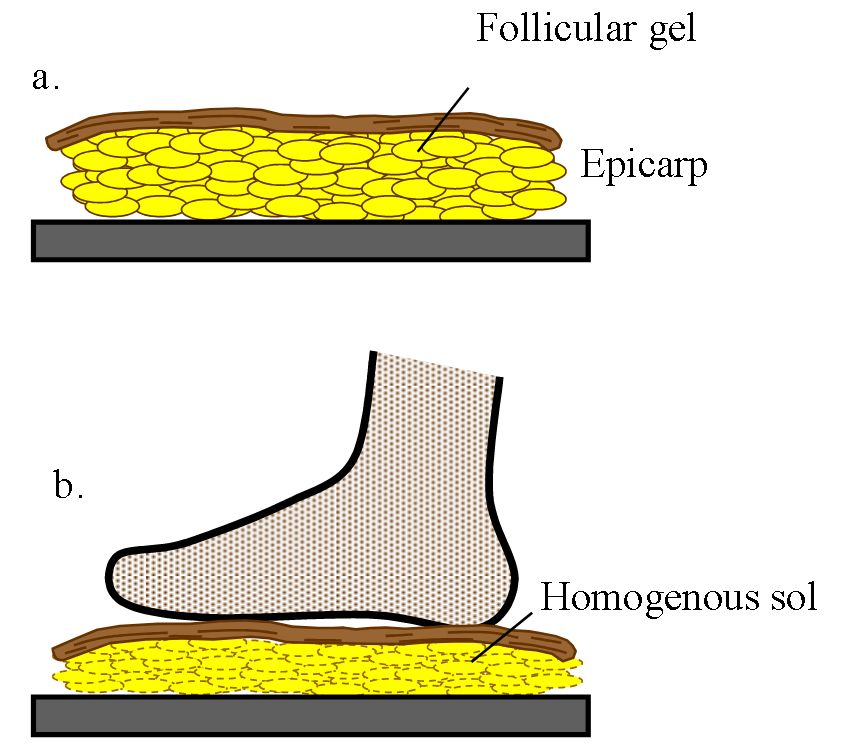
The peel of an apple / lemon / mandarin contains so-called. follicular gel in quantities much smaller than the banana peel, so the friction coefficient of these materials is very different from the banana. The Japanese called this mechanism a follicular gel lubricant and predict that in the future their research could give impetus to the development of a whole class of vegetable lubricants of a similar structure.
To the note : one of the banana-skin peels is the Internet fallacy that ships are still being launched in India with the help of thousands of crushed bananas. Was not lowered and lowered and the Indians and the Americans during World War II (and bananas - because cheaper than any other lubricant)
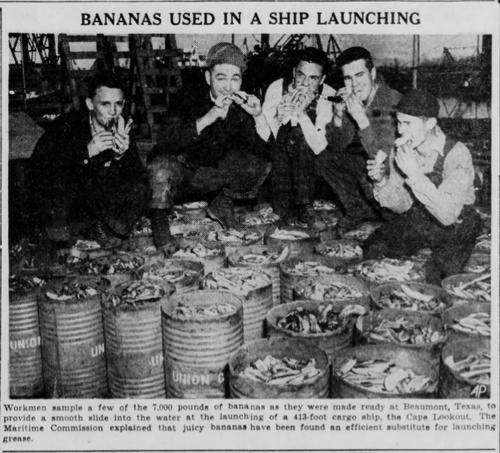
The second characteristic feature of the banana peel after the ability to slide, is the ability to publish an indescribable and unique banana flavor.
What do you smell in my ...
If you ask the average citizen to describe the fruit smell of a banana, then with a high degree of probability the answer will be “smells like banana”. The aroma is unique and unlike anything. In the perfume industry, notes of a banana are not particularly popular due to the complexity of the synthetic repetition of the composition of natural essence. There are far fewer compositions with the use of banana notes than, for example, with an apple or citrus, and there is no such thing where a banana is the main component - not at all (well, or I am not well informed in perfume novelties).
I think many knew they guessed that the whole banana flavor was concentrated precisely in the peel. It is a mixture of about 50 chemical compounds. The picture under the spoiler shows the "full display":
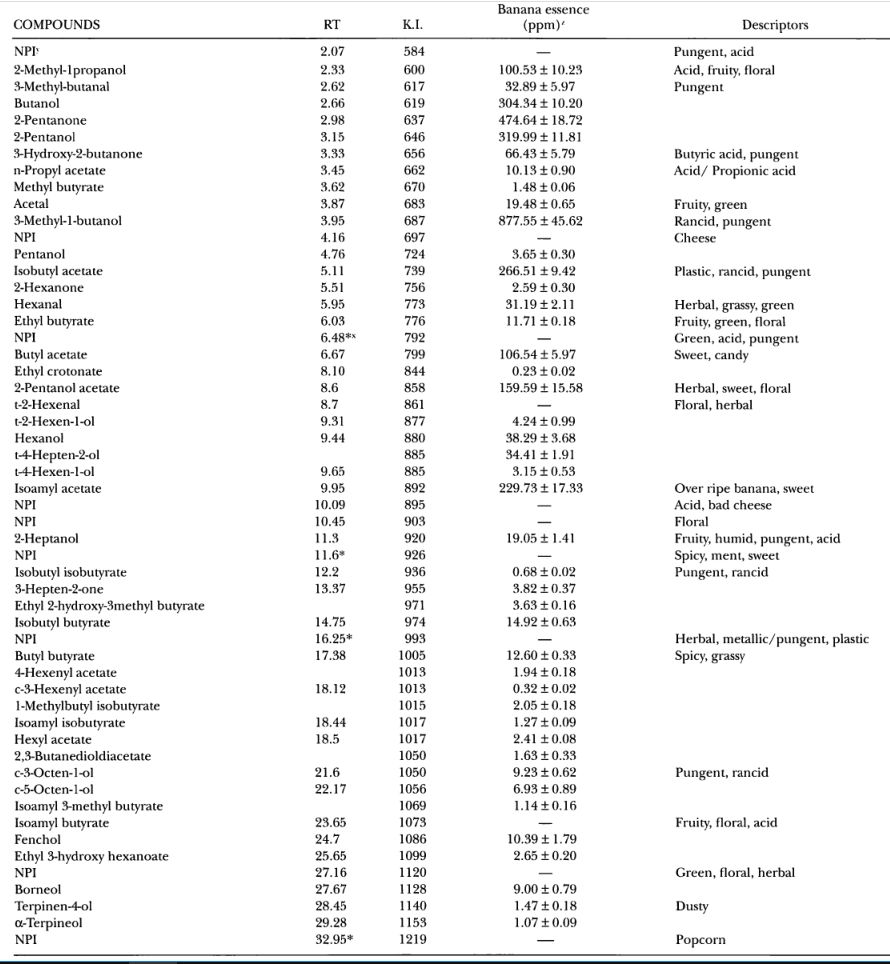
In this and specific case, 43 compounds were found in the extract, 16 of them are alcohols, 20 ethers, 2 aldehydes, 4 ketones, 1 acetal. The maximum content falls on 2-pentanone, 2-pentanol, butanol, isobutyl acetate, isoamylacetate, 2-pentanol acetate, 2-methyl-1-propanol. In the process of ripening a banana in the peel, the content of such esters as isopentyl acetate and isobutyl acetate increases. According to many studies, it is believed that aldehydes are the most volatile components in green bananas, but esters in ripe yellow ones. Therefore, esters are considered the main carriers of "banana flavor." The simplest synthetic fragrance "banana" (found in household chemicals sometimes) is, as a rule, a mixture of isobutyl acetate and isoamylacetate. But you can imagine (by looking at the table above) how far it is from the smell of a live banana.
To the note : one time there was a rather stubborn rumor about the fact that the aroma of a banana helps to lose weight. The whole case was based on an article 25 years ago, in which an experiment was described, during which people who inhaled fruit flavors before eating could lose weight. The press and various resources devoted to the issues of healthy lifestyles / nutrition, etc. were repeatedly referred to this article. In fact, Mr. Hirsch (the author of the article mentioned above) just started to release his own dietary supplement (banana-like powder for sprinkling over cooked dishes, read “gluttonous repellent”) and successfully sold it. BAA was called Sensa , and was quickly removed from the market after the FTC (US Federal Trade Commission) finedmanufacturer for false performance claims. Nevertheless, this bike continues to walk on the Internet until now.
Due to the ability to effectively give banana flavor products peel is actively used as a "fragrance". For example, in the process of making a special vegetarian dessert on the grill:
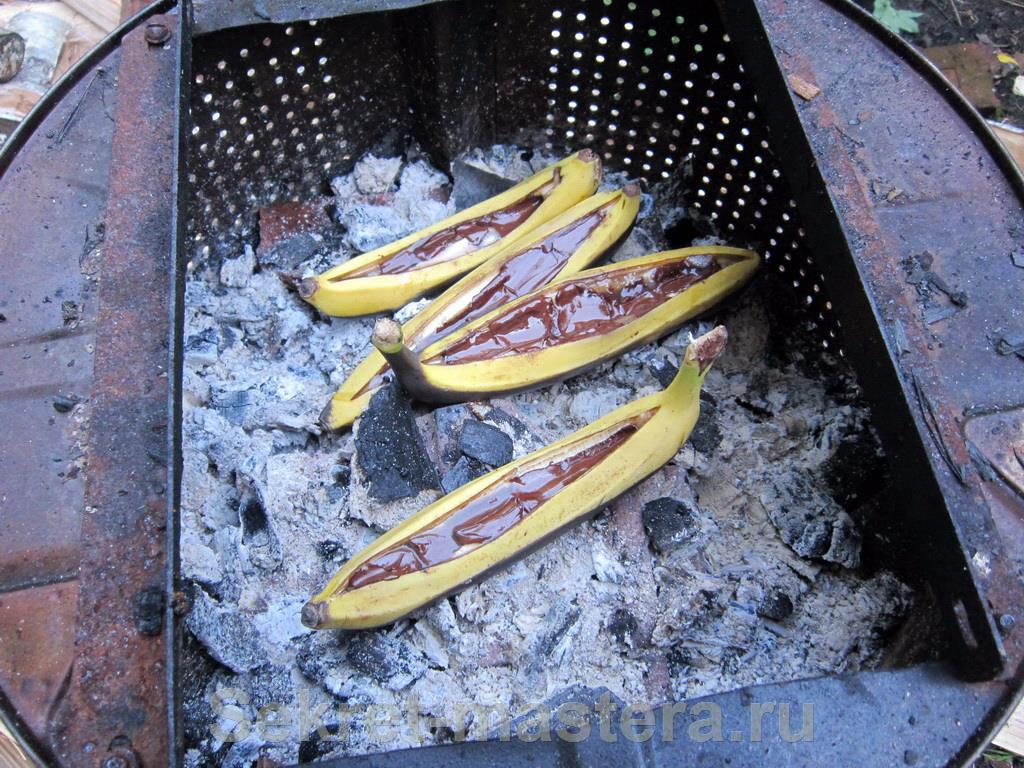
For cooking you need a bunch of bananas and a bar of chocolate. Bananas need to take such as at number 8 in the picture.
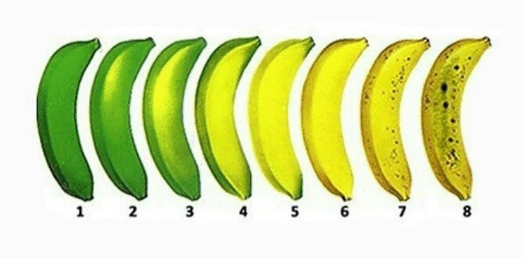
Разрезаем шкурку банана, так чтобы получился "кармашек", прорезаем наполовину мякоть. Отламываем ряд плитки шоколада и делим его на 6 частей. Именно столько шоколада поместится в большой банан. Помещаем бананы в мангал на гриль решетку разрезами вверх, а если угли уже прогорают, то прямо на угли. Контролируем процесс приготовления. Сначала наружная шкурка начнет темнеть и сердцевина даст сок. Затем сердцевина начнет размягчаться и шоколад плавится. Полное расплавление шоколада говорит о готовности продукта. Десерт из бананов готов. Перекладываем на тарелку и подаем к столу, есть, кстати, приятнее чайной ложкой :)
Banana smell in cooking is best suited for a variety of vegetarian desserts or sugary drinks (including liqueurs). Although in some Asian countries with a banana peel they prepare both beef and tough mutton (including spreading the meat on a "pan" of banana peel). You can cook rice in such "containers".

Well, in the end can and can it be so? Hindus because their chutney cooked from the rind. Read to the end - it will be clear, you can or can not eat. For now - a minute of official news under the spoiler.
"Банановая кожура вкусней и полезней самого банана. Никто об этом не знает, потому что никогда не пробовал" — говорят нам "ученые-абсурдопедисты". Так вот, ели. И даже в новостях сей факт зафиксировали...
Since, incidentally, the conversation went "for food", it is impossible not to mention the white threads that are on the inside of the peel and are much loved by no less than a banana.
Phloem
I often watch a picture of a young mother watching a child eating a banana, the instructive tells him “don't eat skin”, and the child is trying to eat white loose fibers of the peel at this time. For some reason, many absolutely not justified believe that these fibers are harmful. And in fact, this is nothing more than those very coarse dietary fibers that many people buy "to improve intestinal motility and eliminate digestive waste." In spite of the fact that in the article about the green banana, I briefly explained why resistant starch from unripe bananas is better than dietary fibers, for those who do not like and cannot eat unripe bananas, the peel fibers are a pretty good compromise. The scientific name of these white edible threads is phloem .
Phloem (from the Greek. Φλοῦς - bark) - the same as phloem - conductive tissue of vascular plants, along which transport of photosynthesis products to parts of the plant in which it does not occur: underground parts, growth cones, flowers, fruits, etc. Together with xylem (wood), providing the transport of water and mineral salts, forms conductive beams.
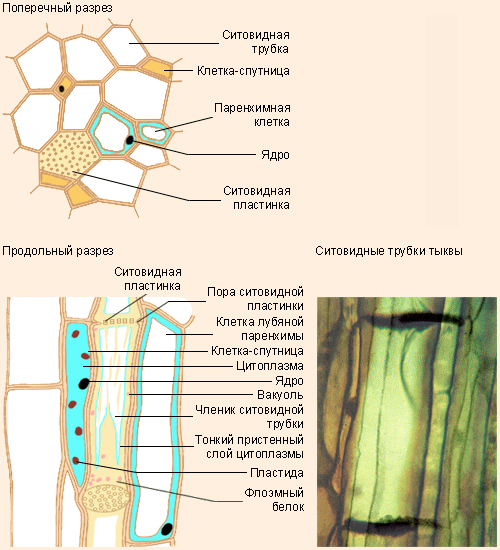
So, in general, phloem is completely edible, and banana phloem still contains more dietary fiber than other fruits. No one has any objections to the fact that apples and pears are used with the peel. Another thing is that the thickness is different and slightly different composition. But in general, no one will eat only "conductive fibers", so it will not deal a blow to the diet. Although from the point of view of the inventive approach, any banana tends to eat along with the peel (like the same apple). And here there is even some success, moreover, it is expected - from the Japanese .
An invention, more specifically a special agrotechnical approach (banana bonsai) to the cultivation of bananas belongs to the Japanese agricultural (!) research (!) company D & T Farm, whose employees managed to bring a banana with edible peel (variety Mongee). The technique there is something like this: seedlings of banana bushes that have grown to a certain level are frozen at -60 ° C. Then the bushes are thawed and transplanted. Due to temperature stress, the fruits begin to grow faster, and the skin texture becomes similar to lettuce leaves - very thin and pleasant to taste. The taste of new bananas is sweeter than usual - each has about 5 grams of sugar more (by the way, because of this method of cultivation, the release of volatile components responsible for the banana flavor is greatly aggravated). Why are these bananas still not on sale? But because the technology is very expensive, and each such banana (a couple dozen of which goes to Japanese stores) costs about $ 6
On the whole, not everyone will like the complete disappearance of the peel on bananas, at least those who sit tightly on the well-known drug "bananindine", which is prepared from the phloem threads mentioned earlier, will protest. In order not to shine - all under the spoiler.
Помню еще в школьное время существовала "городская легенда" про то, что если накрести волокон с внутренней стороны кожуры банана (снятых с 3 кг бананов), варить их до коричневого цвета, а затем скурить — то можно получить непередаваемый профит. Не знаю, пытался ли кто-то эту процедуру провести до конца, но… Но с появлением доступного интернета удалось узнать о том, откуда эта городская легенда взялась.
Началось все с того, что в марте 1966 года внезапно был выпущен хит исполнителя Donovan "Mellow yellow" о курении банановой кожуры.
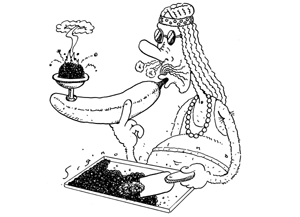
Подлила масла в огонь и альтернативная газета (самиздат) «The Berkeley Barb», которая на своих страницах в 1967 году опубликовала сатирическую статью, в которой говорилось, что от курения сушенной банановой кожуры можно опьянеть (согласно информационных данных издания, его действие похоже на действие опиума с некоторыми фрагментами псилобицина). Видимо, при публикации забыли добавить тег <...sarcasm...> <.../sarcasm...>.
Самиздат-культура на Западе традиционно сильна, поэтом по эффекту домино в том же 1967 году, бананадин был описан в статье в New York Times Magazine под названием «Cool Talk About Hot Drugs».
Ну удивительно, что народ воспринял написанное всерьез. Пионерами курения банановой кожуры стали студенты и тренд обрел, как сейчас говорят, вирусную популярность. Ради шутки один из конгрессменов штата Нью-Джерси представил на рассмотрение Конгресса два новых акта – "Акт о разоблачении и составлении отчетов по иным странным фруктам 1967 года" и "Акт маркирования бананов 1967 года". Продавцы бананов не на шутку встревожились ("а вдруг запретят") и обратились в FDA с запросом о галлюциногенном эффекте банановой кожуры. После длительных и тщательных исследований был провозглашен вердикт – что-то вроде "бананы являются прекрасным источником калия и волокон, но определенно не из галлюциногенов". А максимум что можно получить о курения "повидла из банановых шкурок" — тошнота и отравление угарным газом от дыма.
Вторую жизнь этот мем обрел после публикации в 1970 году книги Уильяма Пауэлла (William Powell) «Поваренная книга анархиста», в которой рассказывается, как можно в домашних условиях (без всяких там лабораторий, высших образований и т.п.) взять и запросто изготовить различные полезные вещи — от самодельной бомбы до ЛСД. Там же был и рецепт Musa sapientum Bananadine "мелкого черного порошка кожуры банана, пригодного для курения":
Купите 15 фунтов спелых желтых бананов. Очистите все 15 фунтов и съешьте мякоть. Оставьте только шкурки. Острым ножом очистите внутреннюю сторону кожуры и соберите все вещество. Положите все собранное вещество в большую кастрюлю и добавьте воды. Варите 2-3 часа, пока не получите консистенцию твердой пасты. Выложите пасту на противень и сушите в печи 20 минут или 2 часа. Получится темный порошок, примерно около фунта бананадина. Обычно эффект чувствуется, если выкурить 3-4 сигареты с бананадином.
Несмотря на то, что задумывался этот ход (= флеш-моб) с целью заострения внимания на этичности незаконного изготовления психоактивных препаратов и судебного преследования тех, кто их принимал, эффект получился прямо противоположный. На пост-СССР территории из-за железного занавеса этот тренд попал только в начале 90-х, но тем не менее, пару сотен или тысяч человек кожуру на своем веку поскребло :) Для тех, кто прочитав написанное мной, все равно ничего не понял, скажу как фитохимик, что "повидло из флоэм" настолько же психоактивно, как и повидло из дубовой коры "из луба дуба" (резонное уточнение от Squoworode). Максимум, что можно получить, это отравление угарным газом.
Remembering the beatniks, the hippies and everything psychoactive, it’s not a sin that will return to the chemical characteristics of the peel.
Why does the skin turn black?
Before proceeding to the consideration of the mechanism of darkening (blackening) of the peel, I would like to tell you about an interesting feature inherent only in the peel of a banana. To begin with, the degradation of chlorophyll, as is known, is one of the reasons for the autumn color change of foliage on trees and the coloring of ripe apples and pears. Usually in such cases tetrapirrols are formed, incapable of fluorescence. And here again shows the unusual banana and its inherent banana peel. In ripening bananas, chlorophylls disappear, turning into unique fluorescent catabolites (fluorescent chlorophylls catabolites, FCC), causing yellow bananas to glow blue when observed under ultraviolet radiation.

The authors of the study found that among the decomposition products of chlorophyll there is a fluorescent chlorophyll catabolite 56 (FCC-56), which in the process of maturation turns into a catabolite FCC-49 . In this way, the banana peel, as it signals the change of stages from "mature" to "rotten."
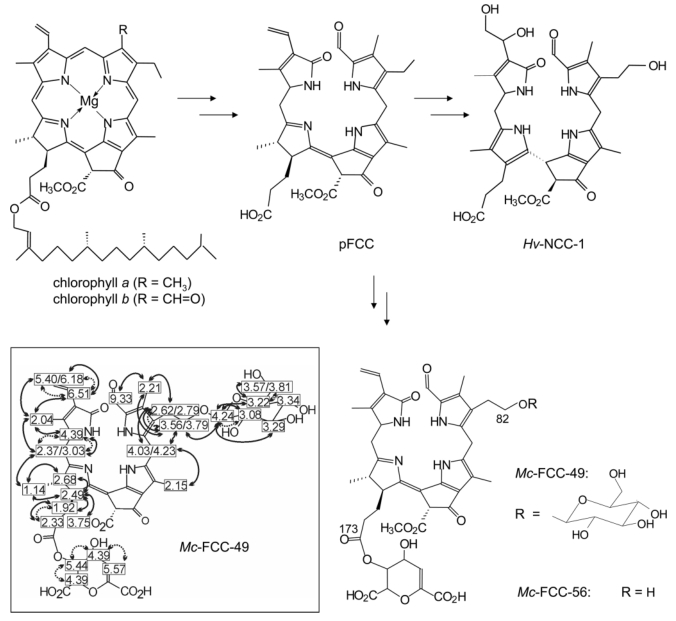
Researchers suggest that this mechanism allows animals that can see light in the ultraviolet spectrum ( tetrachromats and pentachromats ) to more easily detect ripe bananas. Although it may be useful to people, especially those who have collected a portable UV lamp of "black light", as described in the article How to escape from "hares". Instructions for anti-UV method.
На картинке представлена диаграмма, показывающая относительное количество флуоресцентных катаболитов (FCC) в экстрактах из кожуры незрелого зеленого банана, свежего обработанного этиленом банана (день 0) и этилен-обработанного банана, который зрел от 1 до 5 дней в хранилище при комнатной температуре

With the identification figured out, now you can safely go to the enzymes. So, as you know, banana peel tends to darken, and darkening is not associated with a deterioration in the taste of a banana inside, but on the contrary - for most consumers (except those who are prescribed a green banana ). The ongoing process is nothing more than a so-called. enzymatic darkening (eng. enzymatic browning ). This process is observed in fruits / vegetables and even seafood (shrimp, lobster and crabs). On the one hand, the process seems to damage and spoil the presentation, but on the other, if it were not, we would not know the color / taste of tea (including the one that is Ivan-tea, it is now fashionable to ferment), coffee, chocolate. Darkening is a natural natural process (“nature paints.” The polyphenols already familiar to my regular readers act as a basis for “colors” on the vegetable “canvas.” I described the phytochemist. Persimmon when describing natural antioxidants. And Various enzymes, for which polyphenols are substrates, act as “brushes.” As an initiator of the enzymatic browning mechanism, any process that causes the destruction of plant cells can act. In a banana ozhure, as banana ripening in the cell membranes begin to subside (due to dissolution of the pectin ). The picture below shows SEM-photograph of the cell walls "aging" banana.

In the green banana, there is no noticeable degradation of the cell structure (option a) in the picture). With the onset of yellowing of the peel (Figure c), small tears in the cell tissue become noticeable. Before destruction, there is some thickening (swelling) of partitions in the cell walls (variants c) and d) in the picture). Gradually, the boundaries between the cells become fuzzy, which is associated with an extensive loss of cell integrity and the subsequent release of cell contents (as in the crush of the Japanese experiment). And at the yellow skin stage, the cells were completely destroyed and the cell wall structure became heterogeneous (variants e) and f) - for a banana ripening at elevated temperature). The disappearance of an ordered cellular structure at the yellow skin stage is caused by the aging process. Consideredthat aging with violation of the integrity of the cell membrane allows phenolic compounds (for a banana it is dopamine, leukodelphinidin, leukocyanidin) in the vacuole the cells come into contact with enzymes like polyphenol oxidases. Polyphenol oxidases are a class of enzymes that were first found in fungi and widely distributed in nature. Apparently, they are found in plastids and chloroplasts of plants, although they freely exist in the cytoplasm of aging or ripening plants. Polyphenol oxidase is believed to play an important role in plant resistance to microbial and viral infections and adverse climatic conditions. In the presence of oxygen from air, the enzyme catalyzes the first stages of the biochemical transformation of phenolic compounds with the formation of quinones, which undergo further polymerization with the formation of dark insoluble polymers called melanins. Melanins form protective areas with antimicrobial properties, and thereby preventing the spread of infection in plant tissue. An example of the formation of melanins from simple polyphenol, tyrosine, is shown in the figure below:
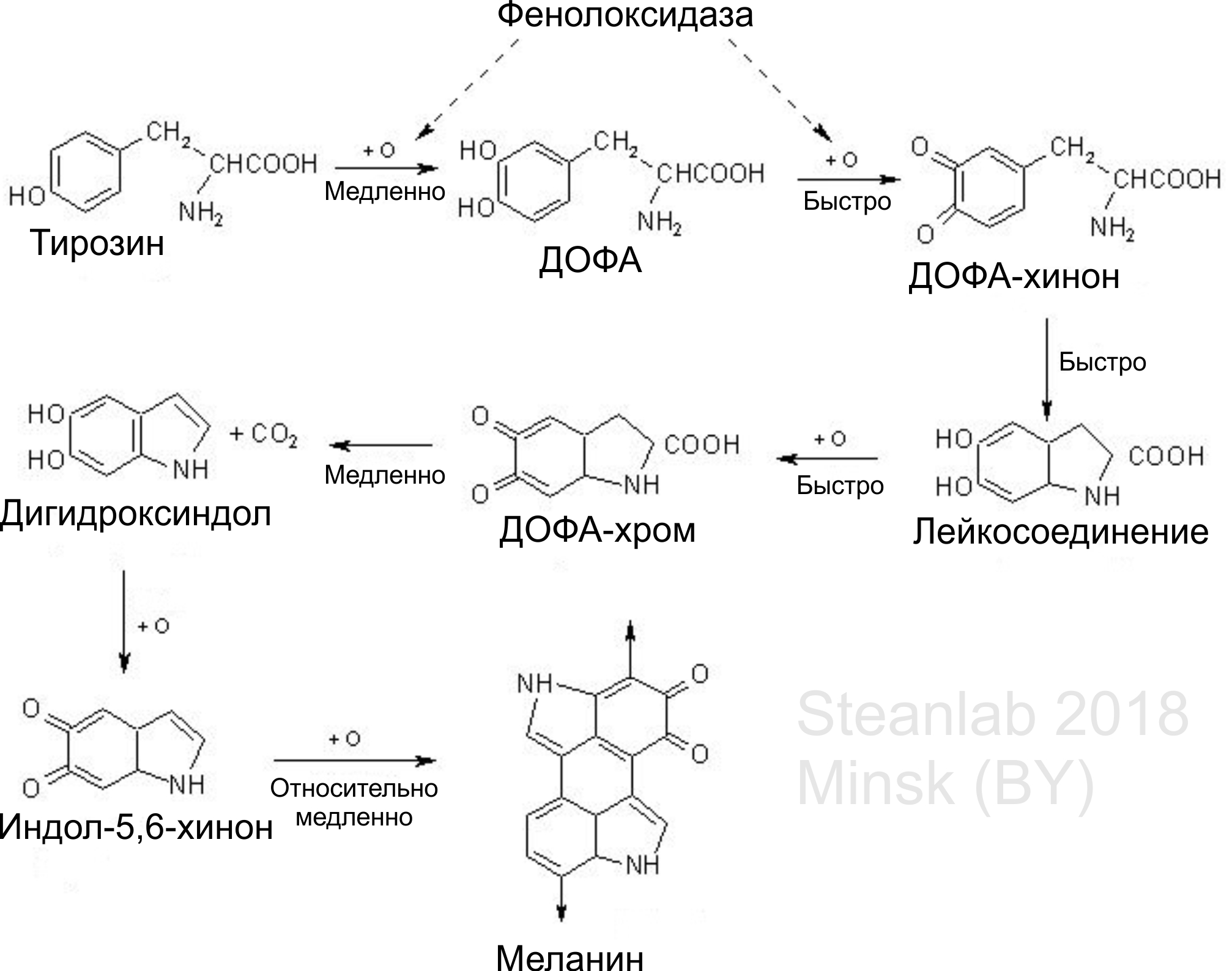
To the note : so, roughly speaking, the blackened skin of a banana is much closer to the skin tanned in the sun / solarium than it might seem at first glance. Some plants, like banana peel, can biosynthesize melanin in their tissues, this variation of melanin is often also called catecholmelanin. But I do not advise grabbing and eating the blackened skin, if only because the known antioxidant and anti-cancer effect of melanin is directly proportional to the degree of its polymerization or molecular weight. Those. if high molecular weight melanin protects skin cells from damage by ultraviolet radiation, reducing the risk of cancer, the low molecular weight, on the contrary, is a pro-oxidant and stimulates the occurrence of free radicals. And in the peel, of course, no one follows the degree of polymerization ...
We continue to talk about the blackening mechanism in general, and about the enzymes involved in this in particular. So, polyphenol oxidase catalyzes two main reactions: hydroxylation and oxidation. Both reactions use molecular oxygen (air). The reaction depends not only on the presence of air, but also on pH (acidity). The reaction does not occur in acidic (pH <5) or alkaline (pH> 8) conditions. A banana supplier may ask, “What should I do to save it?”. And you need to do something inactivate in some way the enzyme (freeze, heat or the like) or remove some components (at least oxygen) from the reaction.
For a banana, the best methods for protecting against enzymatic browning are the following methods (and / or ... choose the one that best suits or even combine them all at once):
1) Immersion in an antioxidant solution and aging in it for 2 minutes:
Calcium chloride 1%
Ascorbic acid 0.75%
Cysteine 0.75%
2) Coating bananas with a solution of carrageenan with a concentration of 5 g / l.
3) Storage of bananas in the atmosphere with a controlled composition (3% O 2 + 10% CO 2
Есть и для яблочек. Для предотвращения ферментативного потемнения нужно:
Погрузить яблочко в раствор 1% аскорбиновой кислоты и затем обработать ультразвуком с частотой 40 кГц
или
Погрузить яблочко в раствор 2% аскорбиновой кислоты + 0,5% хлорида кальция и покрыть 1% раствором хитозана
или
Погрузить яблочко в раствор 0,5-1% аскорбиновой кислоты + 0,1-0,5% цистеина + 0,005-0,02% гексилрезорцина и покрыть пчелиным воском
But even in the case of enzymatic darkening there is some ambiguity. And there is a natural desire to do harm in favor. After all, if we control the cell membranes manually, then in this way we can make this process happen quickly and in certain places. Piercing a banana peel with a needle will create a distinct brown dot in minutes. Making a lot of points, we can draw a picture on a banana peel.
No wonder that someone has already taken advantage of it. Today, more and more artists are starting to use banana as a material for drawing on a banana peel - also known as the " banana tattoo ". Pierced spots on the peel, when in contact with air, turn brown in color, revealing the author’s drawing. The colder the fruit, the faster it comes in contact with the air and turns brown. In addition, by controlling the depth of immersion of the needles, you can create different textures and shades of brown.
The most famous banana artists include the following:
Stephan Brusche (aka iSteef ) from Rotterdam
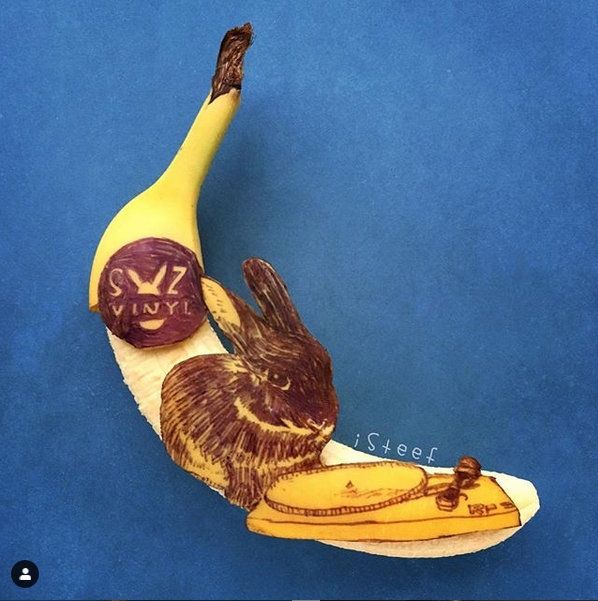

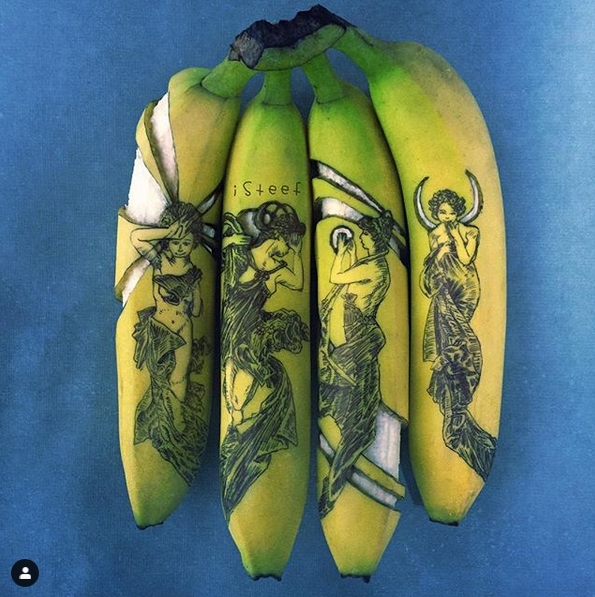

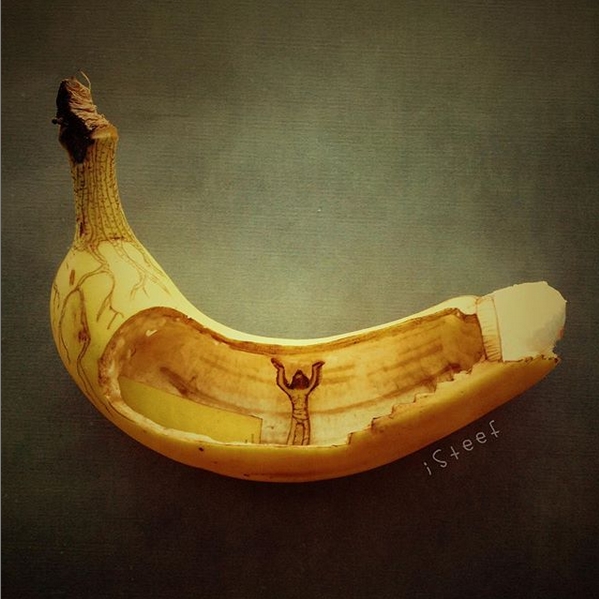

Next we have a Japanese artist Daisuke Skagami under the nickname EndCape . Each work of a 40-year-old artist takes about five hours.
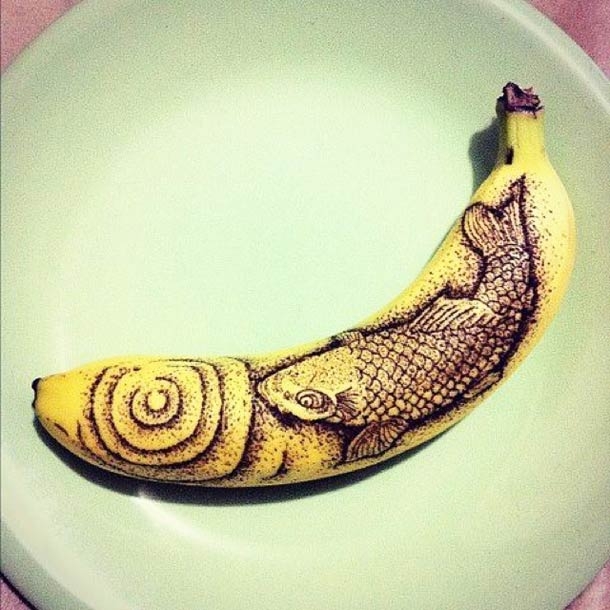
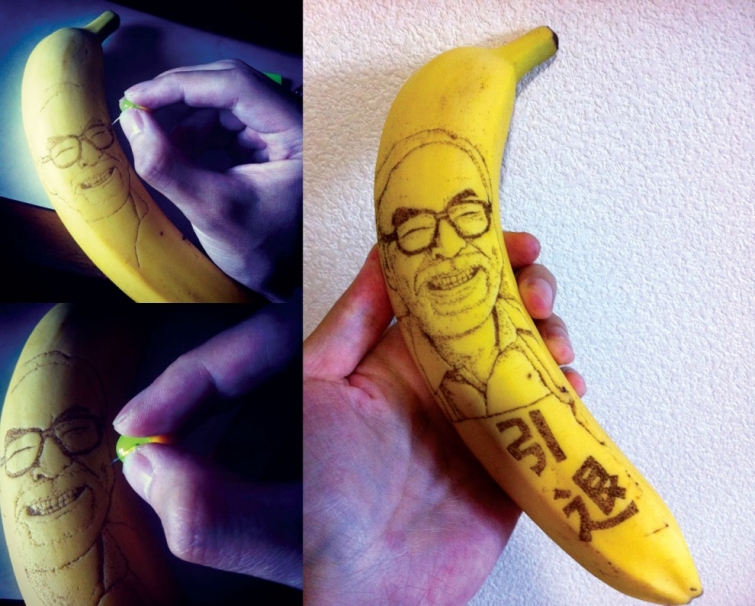
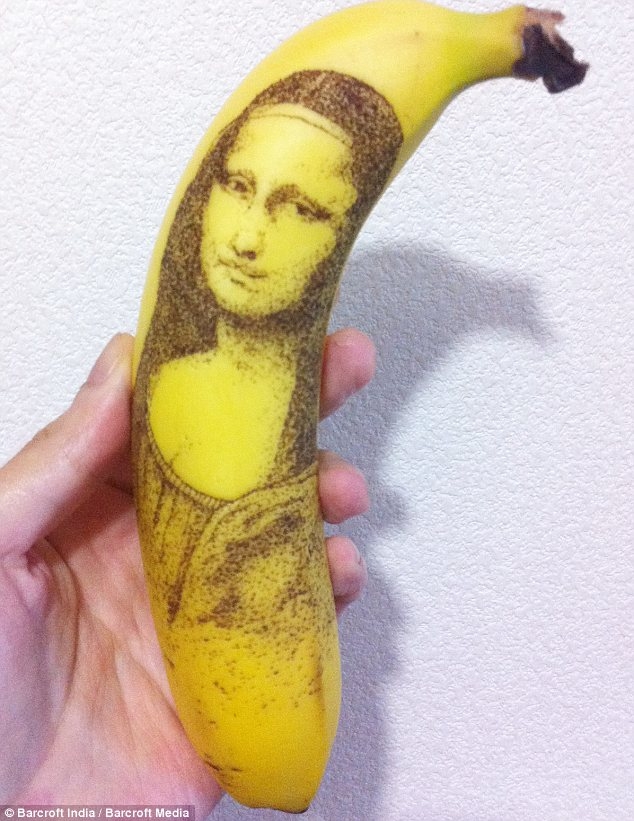
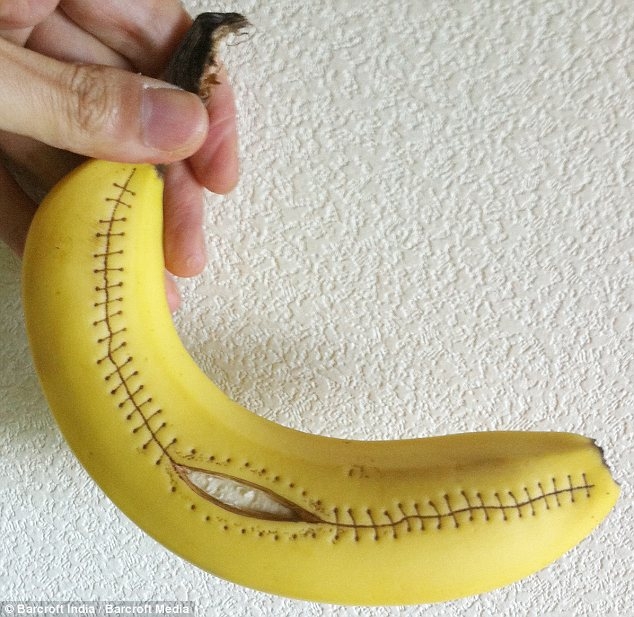
And someone RitaColt aka Honey

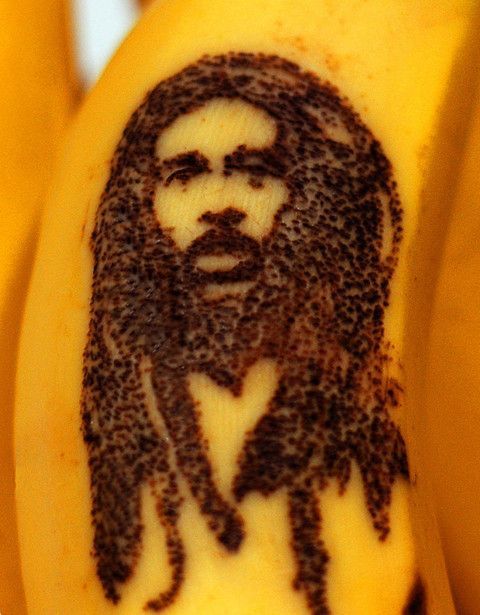
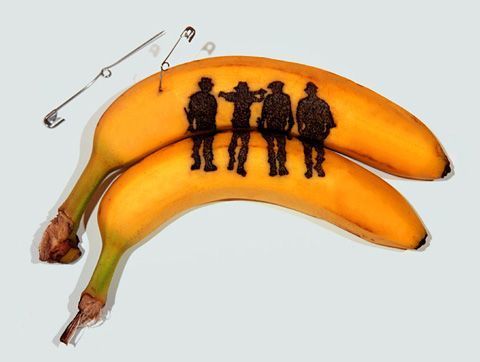
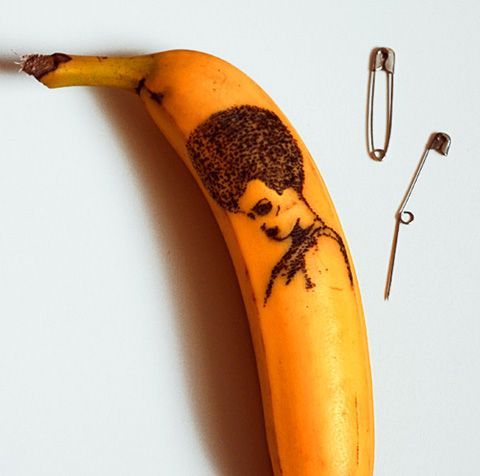
Australian Jun Gil Park in the world of banana artists is known for not piercing a banana peel, but shading it with a regular toothpick. The hue is governed by the degree of depression (almost as in electronic plates for artists) - the stronger the pressure, the darker the pattern in this place. The technique of embossing on a banana ...


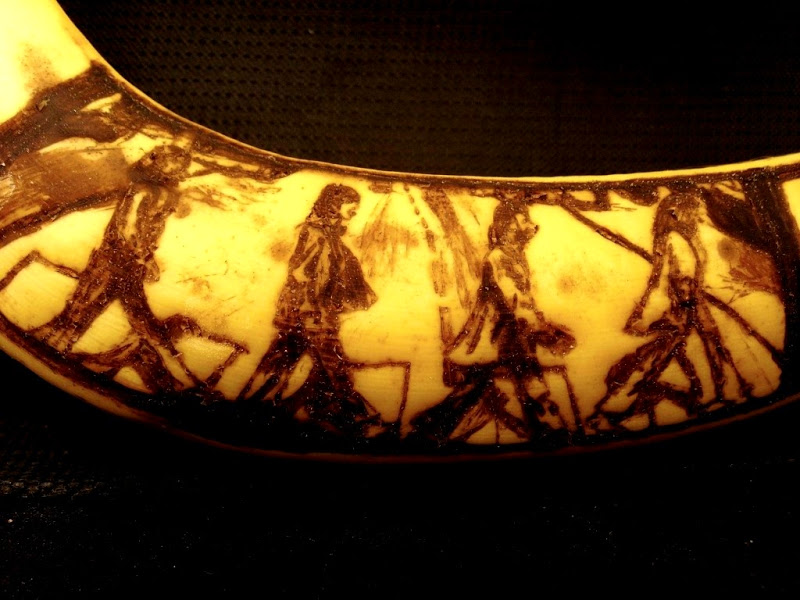
Well, and completes the review of famous artists on banana skins, American artist Phil Hansen (Phil Hansen), who with the help of an ordinary pushpin creates on the banana reproductions of works by Renaissance artists - Michelangelo and Botticelli, as well as paintings by Edgar Degas and Vincent Van Gogh. In addition, Hansen summed up the total banana tattoo skill under the common denominator by publishing the book " Banana Tattoo and Other Ways to Turn Anything into Art " book .
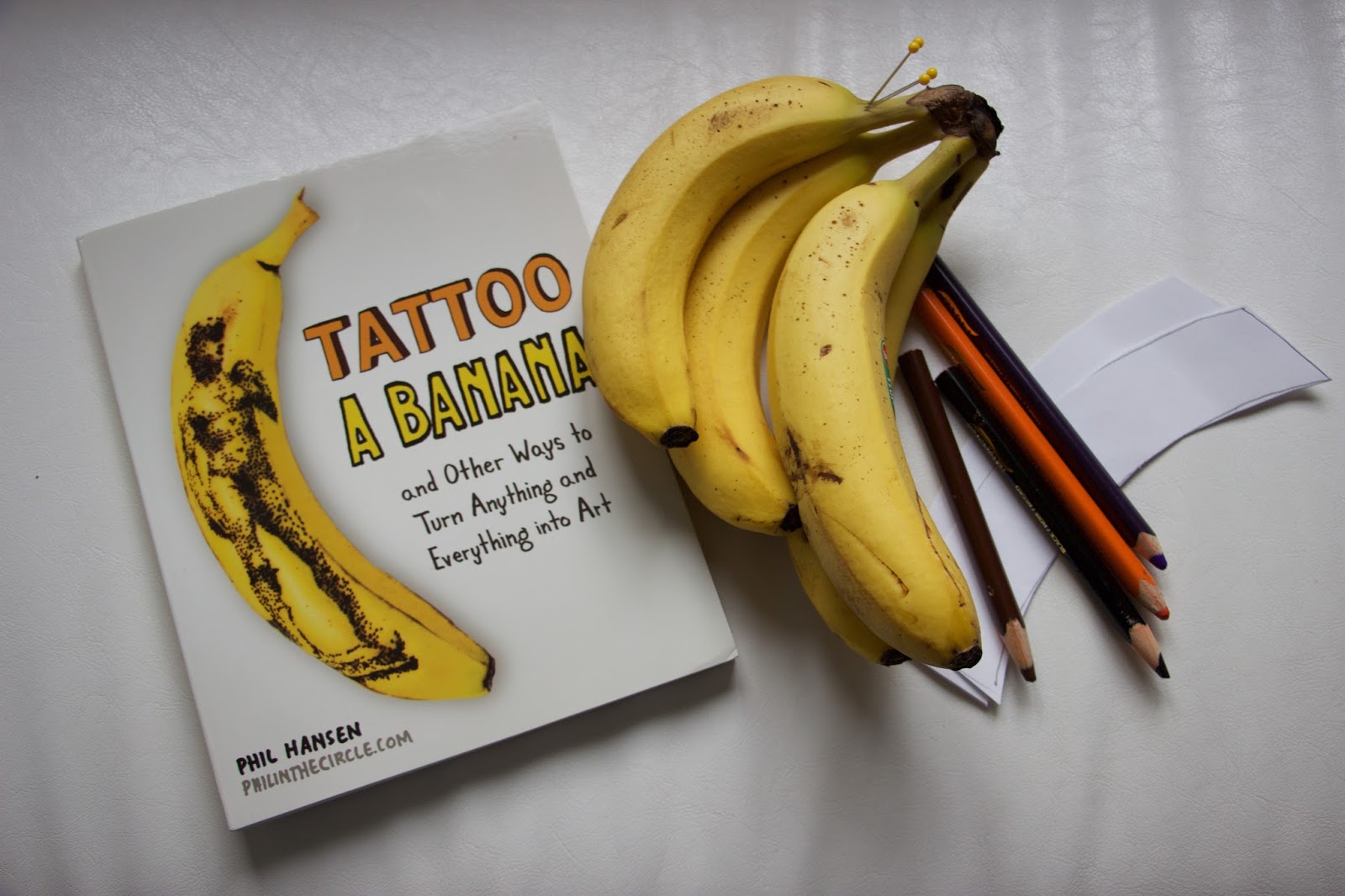
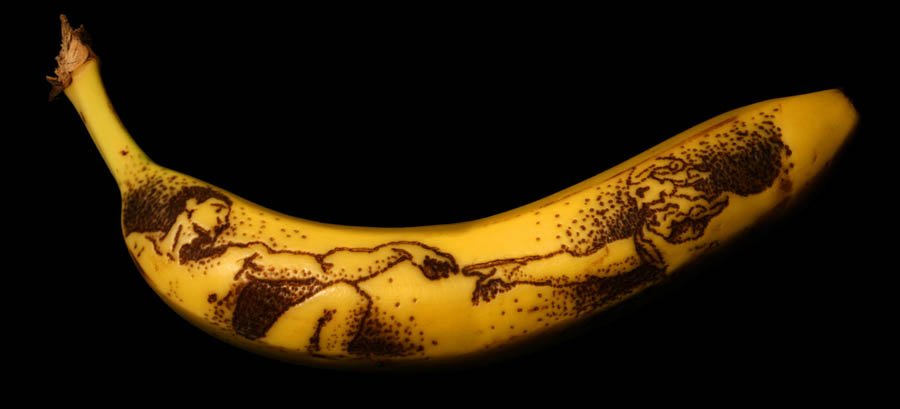
I think no one, after watching there will be no doubt that the banana peel is as valuable as the banana itself. And in order to destroy some of these illusions and substantiate at least somehow the fact of throwing the peel in the garbage, I will describe for some reason the peel is harmful and cannot be eaten (at least raw) from the point of view of phytochemist.
Anti-nutritional substances
The wise nature, unlike a person (like such a "talented" bioherakera), approaches the solution of any task in an incredibly complex way. It is not surprising that many talented engineers and scientists consider beings created by nature, reaction mechanisms, etc., as the standard of excellence. (therefore it remains only to work hard). So, in the process of evolution, most plants have developed their own mechanisms of protection against eating by animals and insects. Including with the help of endogenous "repellents". In foreign literature, these compounds are called antifeedants (English - antifeedants) and are organic compounds that prevent animals or insects from eating plants. As an example, pine rosin, allylmethylsulfidegarlic , etc. Currently, many of the anti-fidants are used as biopesticides, synthetic analogues of natural compounds have allowed the development of new insecticidal preparations. As an example, pyrethrin from chamomile, on the basis of which a whole class of compounds called pyrethroids was synthesized, was synthesized . What is bad for a cockroach is good for a person. Therefore, it is not surprising that a person actively uses many plants containing anti-fidants as spice and aromatic additives (spices). You can recall the mustard and horseradish, which in the case of damage / squeezing begin to release sharp oils containing glucosinolates .
Recently, a similar definition has appeared in human dietetics and nutrition. Such substances are called antinutrients (anti-nutritional substances or anti- fallow , as it is more convenient for anyone to say). Antinutrients are natural or synthetic compounds that inhibit the absorption of nutrients.
Both antinutrients include tannins and lectins (potential anticancer drugs from black spots on a banana peel, which I wrote about in the last article) and many other components (for example, enzyme inhibitors, dietary fiber, chelating agents, proteins, etc.) . On the one hand, for a person who lives under the auspices of "green" eco-food balance is important in everything. And in the absolute majority of cases, for the post-USSR countries, the proverb plays the role of "not to be fat - to be alive." Therefore, pectins are good for us, that marmalades are marketed, and blueberries with its antioxidants are a great success and whatnot. Because the ecology leaves much to be desired, and it is more profitable to bind lead into an insoluble complex and remove it from the body (albeit with zinc, copper, or something else) than to get poisoned.
Стакан наполовину пуст или наполовину полон — общеупотребляемое выражение, используемое как риторический вопрос, позволяющий определить мироощущение человека в целом, либо отношение его к той или иной ситуации как пессимистическое (стакан наполовину пуст) или оптимистическое (стакан наполовину полон). Данная идиома используется, чтобы объяснить, как люди воспринимают события и объекты. Мироощущение каждого человека является уникальным и представляет собой лишь одну из интерпретаций реальности.
It is important that anti-nutritional substances are found in varying quantities in almost all products of plant origin. This information in almost every article I am trying to convey to some commentators. So, guys, today is your day, I admit that anti-nutrients are the dark side of most vegetables and fruits ...
- Ингибиторы пищеварительных протеаз ингибируют действия трипсина, пепсина и других протеаз в ЖКТ, тем самым мешая усвоению белка и перегружая поджелудочную железу.
- Ингибиторы липазы влияют на ферменты (такие как панкреатическая липаза человека), которые катализируют гидролиз некоторых липидов, включая жиры. Например, лекарство от ожирения Орлистат представляет собой ингибитор липаз, превращая все жиры в пищеварительном тракте в не перевариваемые.
- Ингибиторы амилазы предотвращают гидролиз сложных сахаров, и пряпятствуют образованию простых сахаров (вроде глюкозы) и их усвоение организмом. Активно используются при создании диетических продуктов питания и лечении ожирения.
- Щавелевая кислота и оксалаты присутствующие в ревене, чае, шпинате, петрушке связывают кальций и препятствуют его всасыванию в организме человека.
- Глюкозинолаты (те самые, острые, хрен, горчина и т.п.) предотвращают поглощение йода, подовляя тем самым функцию щитовидной железы, и поэтому считаются гойтрогенами (или зобогенные вещества — вещества, способствующие образованию зоба).
- Пищевые волокна сокращают время прохождения пищи через кишечник, не позволяя другим питательным веществам усвоится в ЖКТ.
- Пища с высоким содержанием кальция, употребляемая одновременно с продуктами, содержащими железо, снижает усвоение железа по механизму, с участием железо-транспортного белка hDMT1, который ингибируется кальцием.
- Некоторые белки, например, авидин, содержащийся в активной форме в сырых яичных белках. Авидин прочно связывается с биотином (витамином B7) и может вызывать его дефицит у животных и людей.
- Флавоноиды, представляющие собой полифенолы из подмножества дубильных веществ хелатируют металлы (железо и цинк) и уменьшают их усвоение в ЖКТ, могут ингибировать некоторые пищеварительные ферменты и связывать белки в нерастворимую форму.
- Фитиновая кислота, которая содержится в отрубях и образует не усваиваемые комплексы с магнием, железом, цинком, кальцием. У еще у нее "художественная" формула:

It is worth noting that the level of anti-nutritional substances in modern cultures is constantly decreasing as a result of the process of "domestication" (although, to admit, for the most part, the concentration of anti-nutrients in plant raw materials is too low to present a risk for the health of a healthy person, but a person with chronic diseases may well be enough). So think about this article, when you want to say "purchased strawberries are kind of inanimate, or the matter from your garden". In fact, for people, breeders try. Currently, there is an opportunity to completely get rid of anti-nutritional substances through genetic engineering (GMO-fication), but since these compounds can also have a serious therapeutic and preventive effect, Such genetic modifications will ultimately make food more nutritious, but will seriously weaken its complex health value. Although a man known since ancient times is a method of dealing with anti-ingredients - heat treatment of food and fermentation. Therefore, I have a very great skepticism about all kinds of deviant trends in nutrition, such as raw food, fruitorianism, etc.
Of all the many anti-nutritional substances, I’ll dwell on those compounds that have not previously been encountered in my articles, but are also found in banana peel.
Soap and saponin
First of all, of course, saponins are substances that are glycosidic compounds with steroid (C 27 ) or triterpenoid (C 30) sapogenins core with one or more carbohydrate side chains. Due to their amphiphilic character and surface-active properties, saponins are excellent foaming agents, forming a very stable foam. An important advantage that distinguishes saponins from other anionic surfactants (for example, polyphosphates often used in laundry detergents) is the absence of an alkaline reaction. Most of the saponins are found in the peel of a banana, although in the fruit itself no-no and something is found. By the way, the properties of a banana peel, such as cleaning leather shoes, using as a cloth for cleaning, etc., are associated with the presence of saponins. For those who knew, I forgot, I will remind you why soap washes:
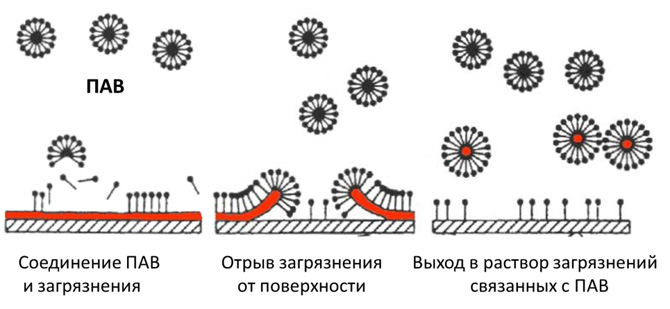
But thanks to their ability to adsorb at the air-water interface, surfactants are a real scourge for fish, etc. aquatic animals due to the limited availability of oxygen (in fact, aquatic inhabitants are dying from suffocation). Indigenous people living by fishing immediately became aware of this, so they still use plant extracts of plants containing saponins for poacher fishing (despite the prohibitions).
If it is not necessary to choose for fish, in the case of terrestrial inhabitants (animals and humans) saponins have a depressing effect on our favorite microbiota, up to complete sterilization of the intestine (% USERNAME%, remember this, pouring Fairi from the heart out on the dishwashing sponges - and carefully, rinse the plate very carefully ...). This is especially dangerous in the case of ruminants. But the latter have learned remarkably how to identify vegetable raw materials with saponins and bypass it a mile away (good, saponins are very bitter in taste, in large quantities). And a person, a person can sometimes not notice ...
Note : saponins of different subclasses are not only in bananas. A person with a saponin core that is unsophisticated in chemistry can most often be found in a) green potatoes - a combination of solanine and b) in a bitter cucumber from a dacha bed - a compound of cucurbitacin . And from the one and from the other "misfortune" the plant can be saved by simply removing the peel. So banana peel and cucumber are close to each other. A vivid example of the truthfulness of the statement "there is a joke in every joke":
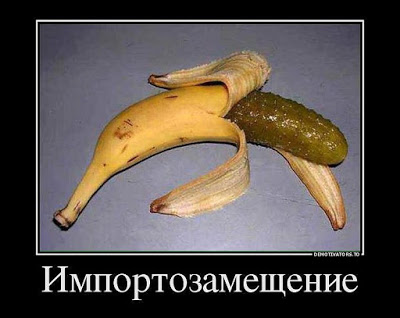
Although for Belarus this import substitution is not relevant, because ( proof + proof ) Belarus has its own bananas.
… Как рассказал корреспонденту агентства «Минск-Новости» главный агроном по защите растений Минской овощной фабрики Александр Радушкевич, урожай бананов собирают дважды в год: в мае и сентябре. На этот раз созрели две ветки весом 5 кг каждая. Плоды отдадут на дегустацию работникам предприятия. Бананы миниатюрные – длиной всего 10–15 см. И очень сладкие. К слову, для выращивания чудо-фрукта на предприятии не используют подкормку и лампы: растению хватает белорусского солнца.
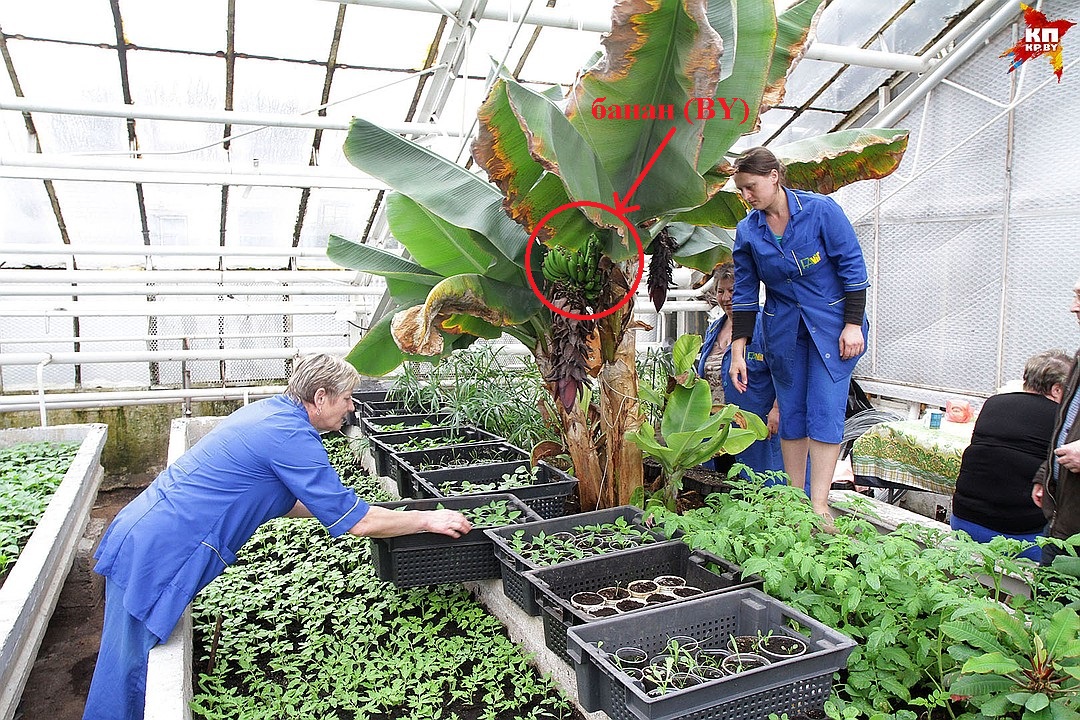
Сразу вспомнилось
Taumatino-like proteins - the basis of sweet taste.
In addition to saponins, the skin of bananas (and the bananas themselves) contains another kind of rather unusual compounds called "thaumatino-like proteins" (English thaumatin-like proteins, TLP) and also fall into the category of "anti-nutritional substances". These proteins are short polypeptides (about 200 amino acid residues in length), resembling protein with a sweet taste in structure, thaumatin (or talin), first isolated from the raw materials of West African shrub Thaumatococcus daniellii aka African seredipipovoy he also catemfe .
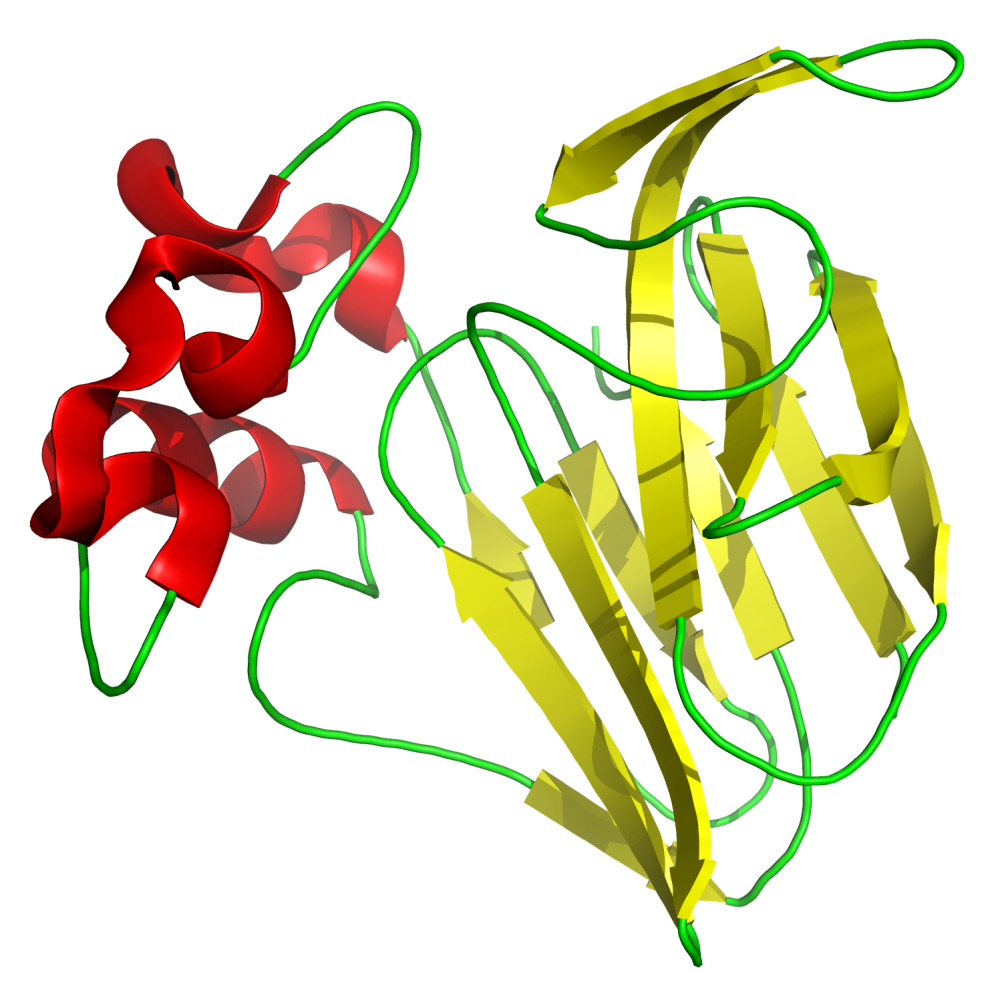
Some of the TLPs found in plants are about 2000 times sweeter than sugar. Despite the fact that all TLPs have a very sweet taste, this taste is significantly different from the "sweetness of sugar". The feeling of sweetness comes very slowly. Feelings last a long time, leaving a taste like licorice. Perhaps that is why thaumatin was approved as a sweetener only in the EU (E957), Israel and Japan. But in the USA it acts only as a corrector of taste (FEMA GRAS 3732), but not as a sweetener.
Why did such cute things get their anti-dignity status? And for the fact that, like saponins, they protect plants from fungal damage through various mechanisms , including a sharp increase in the permeability of the cell membranes of potential pathogens and predators . Although no human studies have been conducted, experiments on cell cultures do not exclude the likelihood of increasing the permeability of intestinal tissues in humans when using TLP. So ... So people with autoimmune diseases (or suspected them) should be careful when including bananas in your diet.
A barrel of honey to fly in the ointment
“Everything is poison, and nothing is poisonous; only one dose makes the poison imperceptible ”(“ Alle Dinge sind Gift, und nichts ist ohne Gift. Allein die Dosis macht, daß ein Ding kein Gift ist ”)
Paracelsus
Once again I carry this quote (clarified, thanks to ra3vdx ) in the epigraph. And now, after reading the section on "anti-nutritional substances", it becomes even more relevant. Since all the useful (and healing) properties of a banana peel, whatever one may say, are associated with the very same, so denounced by some Western researchers, anti-nutritional substances. But on the other hand, a large part of the population does not receive micronutrients not only from vegetable raw materials (vegetarians and the raw foodists mentioned above are not included here) and can sometimes indulge in mustard, indulge in some vigorous, antioxidant fruit (and don’t think about how much zinc or iron did not have time to be absorbed).
Okay, back to our skin. I will not dwell on various artisanal and popular applications, I will briefly describe industrial areas where the banana peel found active use:
To obtain the enzyme cellulase . This enzyme is used to hydrolyze the cellulose of the cell walls of coffee beans or during the fermentation of biomass in the production of biofuels. It should be noted that cellulase is often used to treat phytobezoar (see Persimmon 2.0 Instructions for Use ).
To obtain the enzyme laccase . This enzyme is known for being actively used for bioremediation and detoxification of polluted soils and wastewater. And also to improve the properties of the dough and taste of beer in the food and brewing industry. In addition, laccase class enzymes are among the few oxidoreductases widely used as industrial catalysts.
As an adsorbent for the removal of heavy metal ions from drinking water. An attentive reader will not see anything surprising, since I have repeatedly mentioned both the presence of polyphenols in bananas and banana peel, and the fact that these compounds can bind metal ions (copper, zinc, etc.) to form complexes. Brazilian environmentalists have once again confirmed this fact by using dried and chopped banana peel for water purification. At the same time, 10 minutes is enough for cleaning (
to drink once), and the device itself for water purification, filled with banana peel, can be used up to 11 times, keeping all TTX.All the antibacterial properties of the peel fit well with the properties typical of tannins. The only clarification about "how it works." Either polyphenols directly work with their property of binding to bacterial proteins, or components formed after enzymatic conversion. The picture shows the mechanism by which hydrolyzable tannins degrade to the simplest metabolites. And metabolites, in turn, actively interact with pathogenic bacteria. The same, resorcinol, for example, is a widely used drug in the treatment of skin diseases.

- Those saponins, which are harmful if taken orally, work remarkably as an analgesic and anti-inflammatory agent (the effect on leukotrienes in the metabolism of arachidonic acid). Banana skins are a very good remedy for insect bites - they easily relieve irritation and reduce swelling (especially if there are no more effective remedies at hand)
Conclusions : banana peel - if it is not particularly edible, it can sometimes be useful for many life hacking. Some I even described. So, health to all habr-readers and Merry Christmas!
Sergey Besarab ( Siarhei V. Besarab )
-Moser, S., Müller, T., Ebert, M.-O., Jockusch, S., Turro, N. J., & Kräutler, B. (2008). Blue Luminescence of Ripening Bananas. Angewandte Chemie International Edition, 47(46), 8954–8957
-Singh, B and Bhat, T.K (2003) Potential therapeutic applications of some antinutritional plant secondary metabolites. Journal of Agriculture and Food Chemistry 51: 5579-5597
-Brooks, A.A. (2008). Ethanol production potential of local yeast strains isolated from ripe banana peels. African Journal of Biotechnology 7: 3749-3752.
-Ratule M.T., Osman, A., Saari, N. and Ahmad, S. H. (2007). Microstructure of peel cell wall and selected physic-chemical characteristics of Berangan banana (Musacv. Berangan [AAA]) ripened at high temperature. Asia Pacific Journal of Molecular Biology and Biotechnology 15: 8-13.
-Mokbel, M., Saif, F. and Hashinaga, F. (2005). Antibacterial and antioxidant activities of banana (Musa, AAA cv. cavendish) fruits peel. Asian Journal of Biotechnology 2: 1-4
-Adeniji TA, Sanni LO, Barimalaa IS, Hart AD. Anti-nutrients and heavy metals in some new plantain and banana cultivars. Nigerian Food J 2007;25: 165-170.
-Choehom, R., Ketsa, S., & van Doorn, W. G. (2004). Senescent spotting of banana peel is inhibited by modified atmosphere packaging. Postharvest Biology and Technology, 31(2), 167–175.
http://agris.fao.org/agris-search/search.do?recordID=US9710952
-Bico, S. L. S., Raposo, M. F. J., Morais, R. M. S. C., & Morais, A. M. M. B. (2009). Combined effects of chemical dip and/or carrageenan coating and/or controlled atmosphere on quality of fresh-cut banana. Food Control, 20(5), 508-514.
-Hirsch, A. R., and R. Gomez. "Weight Reduction Through Inhalation of Odorants." J Neurol Orthop Med SufI 16 (n.d.): 28-31. Web. 1 Mar. 2015.
https://www.researchgate.net/publication/284455351_Antibacterial_and_phytochemical_analysis_of_Banana_fruit_peel
-Odebiyi, O.O and Sofowora,E.A(1978) Phytochemical Screening of Nigerian medicinal plants part II. Lloydia 41(1): 234-235
-Liu, J.-J., Sturrock, R., & Ekramoddoullah, A. K. M. (2010). The superfamily of thaumatin-like proteins: its origin, evolution, and expression towards biological function. Plant Cell Reports, 29(5), 419–436.
